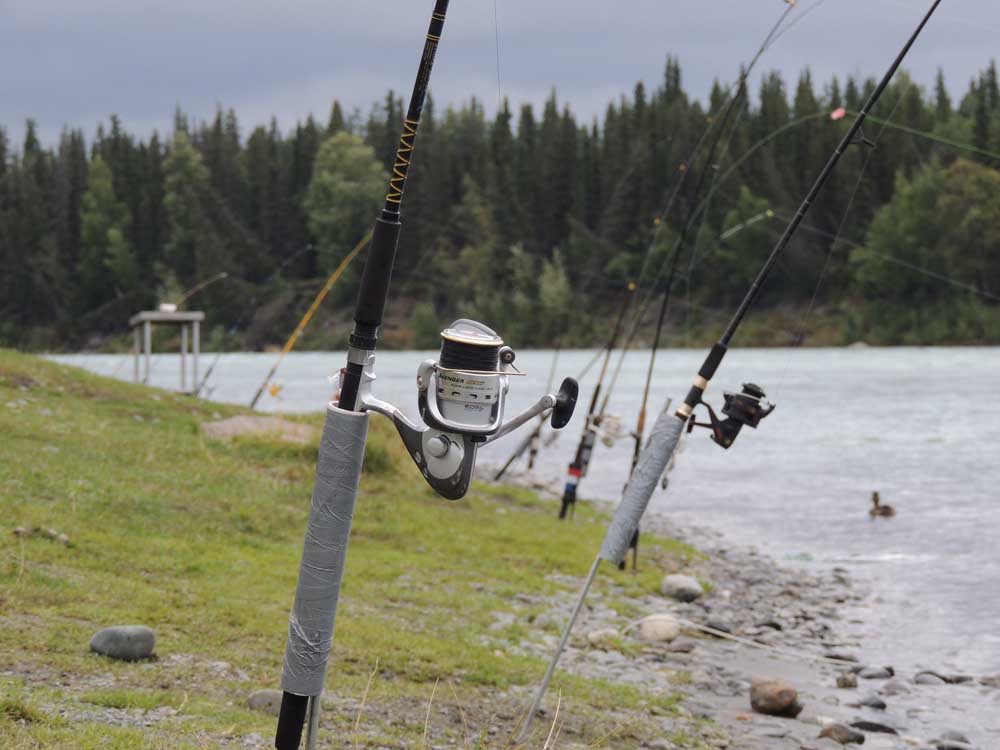In Alaska, anglers turn to conversation during lull
Published 12:00 am Wednesday, February 19, 2014

- Photos by Gary Lewis / For The BulletinA lull in the action on the banks of the Kenai River in Soldotna, Alaska. This is the great thing about fishing: You may not catch a lot, but you and your fishing friends still get to know each other better.
If one was to write down the great places to fish in the world, Alaska would certainly rank pretty high. If there was a month of the year when fish are easy to catch, September must be close to the top of the list.
So it was with a little mirth that I reflected on the end of a day in Alaska last September, when our group of 12 pretty good fishermen managed to get skunked. Not one of us caught a fish the whole day.
That is the great thing about fishing: We may not have been catching as much as we wanted to, but that gave us time to get to know each other. And wherever folks who like to fish come together, some of them are invariably from somewhere else. This is also a good source of mirth. Once, between halibut on a boat out of Yakutat, I asked the guide if he had any good stories about clients.
This, by the way, is an acceptable form of gossip from the client perspective. From the guide perspective, it is considered bad form to report on the sports they fished with the day or the week before. Fortunately gossip is a high art in Yakutat; our guide was forthcoming.
“For the majority of our clients, it is the first trip to Alaska, probably their first trip out of their home state to fish or hunt,” guide Erik Knudsen said. It turns out that we fishing enthusiasts bring our own cultural preferences along.
“The Japanese eat the bait. They want every bit of the fish, the heads and the guts and the roe,” Erik said.
“The Germans can sell sport-caught fish. So we get Germans who will take a three-week vacation to Alaska. They will schedule their trip to catch as many pounds of salmon or halibut as possible. When they get back to Germany they have that fish pre-sold to restaurants and hotels.” Hmmm.
It turns out that some of us folks from the Lower 48 also have a peculiar notion about architecture in Alaska. Erik said one of his clients asked what it was like to live in an igloo. Plywood seems to be a lot more popular with the local contractors than compressed bricks of snow. Blue tarp is another favored building material.
Another man asked how Erik put up with snow in July. Actually it doesn’t snow in July in southeast Alaska. I wonder how they put up with 34 days of rain every month and the mosquitoes on the two days the sun does come out.
When one woman found out he carried a shotgun to dispatch big halibut that can tear up the boat, she asked, “So you really shoot the halibut? How do you shoot them and not put a hole in the boat?”
One question about halibut was posed by this thinker. “If its eyes are on the dark side and the white side is down, how come the white side doesn’t get dirty?” Maybe fish would get dirty if they didn’t go around in water all the time.
After hearing about the salmon spawning run, one woman asked, “Why do the male salmon come up the river?” Just guessing here, but that one probably hadn’t swished her tail in the gravel much either.
Some of the most enthusiastic fishermen are veterans, Erik said.
“In one season, I had four World War II vets out fishing. One was a navigator on a B-17 and got shot down twice. The other guy was ground crew on the Enola Gay. Two weeks later, I guided a German SS soldier from a proud Nazi family. The last one was a Japanese foot soldier and he didn’t want to talk about it.”
One of the most persistent questions, the one that might be the most painful to answer, he said, was the perennial “What is the elevation here?” This out on the ocean where you only get above sea level if you have a good vertical leap.
Another question: “Is that a real rock or a fake rock in the middle of the river?” How do you answer that one?
I once was asked by a guy from Ohio, “How do you tell how big a bear is?” I handed the guy a tape measure and told him you held one end of it at the tip of its nose and stretched the other end to the tip of its tail. He didn’t speak to me for the rest of the day, which was fine with me.
Moose are few and far between in Erik’s hometown, but one tourist managed to spot a cow and a calf and wanted to know, “How big is a moose’s brain?”
“Big enough to fill the space between its ears,” Erik told him. “How big is yours?”
— Gary Lewis is the host of Adventure Journal and author of “John Nosler — Going Ballistic,” “Black Bear Hunting,” “Hunting Oregon” and other titles. Contact Lewis at www.GaryLewisOutdoors.com.






